| Reports of visits to Japan of POWs |
Former US POWs visit Japan
at the invitation of the Japanese Government
|13 Sept. | 14 - 15 Sept. | 16 Sept. | 17 Sept. | 18 Sept. | Mass Media |
How this visit was realized
For the period of between 12 September and 19 September 2010, six former US POWs, who had undergone hardships under Japanese military during WWII, and their family and bereaved family members, a total of 14 people visited Japan at the invitation of the Japanese Government (this project is termed as the Japanese / POW Friendship Program). It has been a long way to go to realize the invitation of former US POWs.
In America, in 1999, the Laws of California were revised, permitting those victims who had been forced to work by Germany and other Axis powers during WWII may ask for compensation and apology from the Corporations of those countries, which made them work like slaves and yielded high profit. Former POWs, Dr. Tenney (leader of the group) and others started a law-suit to the Japanese Corporations where they had worked. However, this law-suit was turned down by the US Supreme Court in 2003, which closed an avenue for them to complain to the court. Dr. Tenney and others have tried various appeals, however, in vain. Furthermore, former US POWs were excluded from the Japanese Government's invitation project for former Allied POWs and their families, which invited some British and Dutch POWs and their family members.
However, in May last year, the Japanese Ambassador to the United States, Ichiro Fujisaki, appeared at the General Assembly of the American Defenders of Bataan and Corregidor (ADBC), and officially apologized them for the Japanese treatment of the POWs in WWII, which became a turning point to improve the situations greatly. This year, 65 years after the war, visiting of former US POWs and their family members to Japan has realized for the first time.
During their one-week stay, they were scheduled to attend meetings with the Japanese statesmen, visiting their old camp sites and the British Commonwealth Cemetery, attending lecture meetings at universities, and all sorts of events. The POW Research Network, together with the members of "US-Japan Dialogue on POWs" and "Japanese Society for friendship with ex-POWs and families", proposed to the Foreign Ministry that the we would visit the places of the visitors' interest with them, and hold an exchange meeting with the Japanese citizens, which were carried out successfully.
On the following day of their arrival, Foreign Minister Katsuya Okada met with the group, and extended his sincere apology on behalf of the Japanese Government. This was an epoch-making event which, we believe, made the former POWs and their family members relieve from a long-years' agony. Although they were not able to have the Japanese Corporations apologize, which was one other thing they had been aiming at, they all said that it was a wonderful journey meeting and getting together with many Japanese people. We were happy to learn that most of them are almost 90-years old, and yet they arrived home uneventfully.
Visiting members
(1) Dr. Lester Tenney (90) Leader of the group & his wife
Bataan Death March > O'Dnnell POW camp > Cabanatuan POW camp > Toko-Maru > Fukuoka No. 17 Branch camp (Ohmuta, Mitsui Coal mine)
(2) Mr. Joseph Alexander (84) & his wife
Surrendered on Mindanao Island > Tokyo Main camp (Shinagawa) > Tokyo No. 2 Branch camp (Ohgimachi, Kawasaki) > Tokyo Main camp (Ohmori)
(3) Mr. Edward Jackfert (88) & his wife
Surrendered on Mindanao Island > Tottori-Maru > Tokyo No. 2 Branch camp (Ohgimachi, Kawasaki)
(4) Mr. Donald Versaw (89) & his daughter
Cabanatuan POW camp > Clark Field > Nissho-Maru > Fukuoka No. 7 Branch camp (Futase Coal mine)
(5) Mr. Robert Rosendahl (89) & his son
Bataan Death March > Shenyang POW camp
(6) Mr. Earl M. Szwabo (89) & his wife
Surrendered on Corregidor Island > Palawan Island > Matemate-Maru > Nagoya No. 5 Branch camp (Yokkaichi City)
(7) Ms. Janice Thompson / Leader of the descendants group (daughter)
Her father Robert Thompson (88); surrendered on Corregidor Island > Bilibid Prison > Ohryoku-Maru (sunk) > Enoura-Maru(sunk) > Brazil-Maru > Moji > Mukuden (present Shenyang) POW camp
(8) Ms. Nancy Kragh / Bereaved family of POW (daughter)
Her father Clarence H. White; Bataan Death March > Ohryoku-Maru (sunk) > Enoura-Maru (sunk & deceased)
Itinerary
| 12 Sept (Sun) | Arrived at Tokyo |
| 13 Sept (Mon) | Meeting with the US Ambassador John Roos / Meeting with Foreign Minister Katsuya Okada / Meeting with Deputy-Chief Cabinet Secretary Tetsuro Fukuyama / Delivered a lecture at the International Christian University |
| 14 Sept (Tue) | Each member visited his/her place of interest, such as old camp site, etc. |
| 15 Sept (Wed) | Moved to Kyoto. |
| 16 Sept (Thurs) | Visiting Ryozen Kannon / Sight-seeing in Kyoto |
| 17 Sept (Fri) | Moved to Tokyo. Delivered a lecture at Diet Members' League to Promote International Initiatives of Change / Joint press conference / Farewell party sponsored by the Foreign Ministry |
| 18 Sept (Sat) | Visiting the British Commonwealth War Cemetery / Exchange meeting with Japanese citizens |
| 19 Sept (Mon) | Departed Tokyo for the US. |
13 Sept. (Mon): Apology of Foreign Minister Okada
On the morning of 13 September, the following day of their arrival, Foreign Minister Okada met them at the Foreign Ministry, and said, "On behalf of the Japanese government, I offer you my profound, heartfelt apology for the inhuman treatment you suffered." Dr. Tenney expressed his gratitude, "We welcome such opportunities." However, he stated that the Japanese Corporations which had forced the POWs to work have remained in silence for 65 years. They should also apologize.
The news were reported by the domestic and international media (see the list of media at the end), and the Foreign Minister Okada wrote his feelings at this meeting in his blog, which follows.
"......being unable to restrain their feelings of 65 years, many of them expressed their feelings. I listened to their stories; and I could not help asking myself that the people of US, who are an ally of Japan, have lived with such feelings toward Japan for as long as 65 years. Why the Japanese government could not have done something much sooner.
......Of course, what those former POWs said were very harsh, but at the same time, one of them has often visited Japan and kept exchange meetings with young Japanese people. We took photos together after the meeting, thereafter; one of them took the trouble to come to me, and told me that although there were cruel Japanese soldiers, there were also gentle and wonderful soldiers
......I strongly felt anew that each of us should be aware of what happened in the past accurately."
14 Sept. (Tue) - 15 Sept. (Wed): Each member visits his/her place of interest
The Tenneys
As mentioned earlier, Dr. Tenney was sent to Fukuoka No. 17 Branch camp after the terrible experiences in Bataan Death March, and was forced to work at the Mitsui Miike Coal mine. Since he had once revisited there, they visited Matsuyama City in Ehime Prefecture to make a visit to the gravesite of the late Mr. Toru Tasaka, who had had a home-stay at their place back in 1968, when he was an exchange student. He passed away last year. Dr. Tennys and Mr. Tasaka had been very friendly over 40 years. Ms. Yuka Ibuki of the US-Japan Dialogue on POWs accompanied the Tenneys. Thru friendly associations with Mr. Tasaka, Dr. Tenney learned of the Japanese culture and the lifestyle, and his anti-Japanese feelings gradually diminished. After making a visit to the gravesite, with Mr. Tasaka's widow, they enjoyed seeing the sights of Matsuyama, including a visit to the famous Dogo hot spring.
With regard to Dr. Tenney's bitter experiences in the Death March, refer to his work "My Hitch in Hell: Bataan Death March," and the US-Japan Dialogue on POWs website. http://www.us-japandialogueonpows.org/
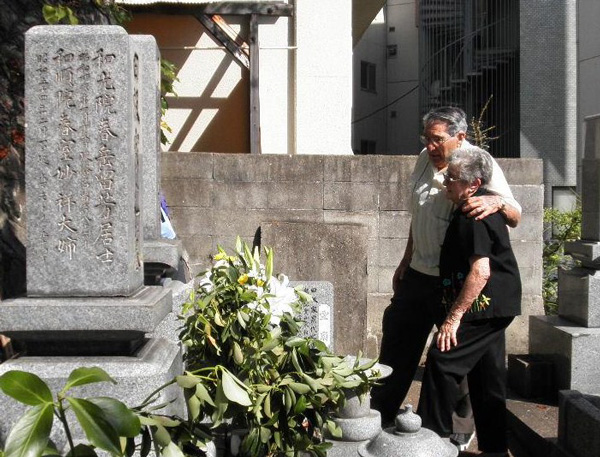
|
|
|
The Tenneys making a visit to the late Mr. Tasaka's gravesite. |
The Alexanders and the Jackferts
<14 September>
In Kawasaki, to begin with, they visited Showa Denko Kawasaki factory where Mr. Jackfert was forced to work. Mr. Koichi Takeuchi, who was a student mobilized for wartime labor service and worked with the POWs in the factory accompanied them for the tour of the factory. Nori Nagasawa and Taeko Sasamoto accompanied then. They were briefly interviewed by CNN, TBS and the Mainich dailies at the gate, and then met with the Director of General affairs at his office. He explained the current operations of the factory, and showed them the photos taken during the war. Mr. Jackfert talked about his job, which was to make ammonia, and very dangerous. Some were burnet. The workshop chief was a very kind person. During air raids, the Japanese evacuated from the factory, but the POWs were left behind. Then he concluded, "I do not have bad feelings toward Showa Denko, but we were made to work on the production of war materials (the factory produced fertilizer and explosive compound) in violation of the Geneva Convention, for which we would like the Corporation to apologize. If the top management of a Corporation like Showa Denko apologizes, it wound encourage other Corporations to apologize. We are not asking for any financial compensation, but just words of apology, which would relieve those who are still suffering from hard memories of those days. We would like to promote reconciliation between the two countries. Please do relay my words to your top management." The Director replied, "I understand." to Mr. Jackfert.
Thereafter, they made a tour of the factory, but everything has entirely been changed since then, and there seemed to be nothing to remind Mr. Jackfert's of those days.
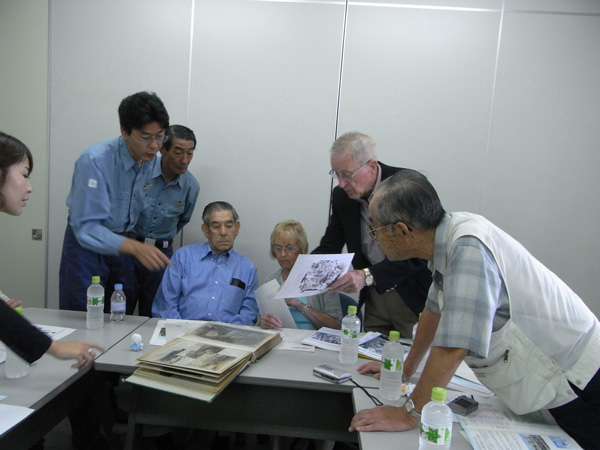
|
|
|
Mr. Jackfert and Mr. Alexander |
They moved to the Mitsui Warf, where Tokyo No. 2 Branch camp had been located. The old office building to the left after passing the gate resembled very much to that of the POWs took a group photo against its backdrop. This company did not accept their visit, not only that, they refused the visitors to enter the company's grounds. Mr. Jackfert took some photos of the company from outside the gate, and then cooperated with the reporters from the media.
Then, they moved to Nisshin Seifun (milling inductor). In the premises of this company was Tokyo No. 24 Detachment. It was, however, closed around the end of June 1945. After Tokyo No. 2 Branch camp was destroyed in an air raid on 25 July 1945, the POWs moved into empty buildings here, and stayed until the termination of the war. The visitors looked at the site from outside, and Mr. Jackfert's visit to Kawasaki was over.
In the afternoon, they visited Mr. Tokio Watanabe (93 years old. After having stationed in Bataan, he was sent to Manchuria. Then he was detained in Siberia after the war) at his house in Oshino Village, Yamanashi Prefecture. Mr. Watanabe treated them to sweet-corns he had grown in his garden. Although there was no connection between them, they enjoyed the meeting and said, "We could meet with each other, because of peace." Then they talked about their experiences in battle fields and forced labor, how meaningless war might be, and the importance of handing down their wartime experiences from generation to generation.
With regard to their wartime experiences, visit the US-Japan Dialogue on POWs website. http://www.us-japandialogueonpows.org/
<15 September>
They visited Omori camp site where Mr. Alexander had been detained. Nori Nagasawa accompanied them. He was only 15 years old when taken POW. He had visited Japan several times before, and had visited the Ohmori camp site with Nori Nagasawa. The camp was located on a man-made island reclaimed from the sea. After the war, things have completely been changed. The cannel just ahead has turned to a speedboat racing area. Now a stadium stands where the camp was located, and there is nothing to think of bygone days. The only thing related to those days is the Peace Kannon standing near the office of speedboat racing.Looking at the memoir, both Mr. Jackfert and Mr. Alexander firmly believed that it describes the hardships they suffered during the war. As it is, it reads, "On Heiwa-jima was a POW camp during the last war, which turned into a place where the war criminals lead sufferings and tribulations of the times. It is what you might call "a place of mysterious workings of fate for war and peace."
Mr. Donald Versaw & his daughter
They visited Fukuoka No. 7 Branch camp (Nittetsu Futase Coal mine) site. Ms. Kinue Tokudome of the US-Japan Dialogue on POWs accompanied them. As to his war time experiences, refer to the US-Japan Dialogue on POWs website.
A total of approx. 600 US, UK and Dutch POWs were detained in Fukuoka No. 7 Branch camp. Mr. Versaw was engaged in a job of scraping and sending up coal to the ground, after it was blasted by dynamite to pieces in the mine about 500-1,000 meters underground. Although the coal mines had been closed, he met with a Mr. Ikenushi, who knows about bygone days at the only existing gate. Mr. Ikenushi was 15 years old then, and talked about episodes when relief items had been dropped from B-29s. Mr. Versaw also talked about how glad he was to receive the relief items, and bartered with the nearby inhabitants. They visited the City archives, where they observed a miniature of the coal mine. Mr. Versaw said, "At the mine, they always said 'Guanjan,' but I still do not know what it means." Mr. Ikenushi replied, "The correct way of saying it is 'Go-anzen ni,' which means, 'I pray to the gods for your safety.'" Whomever you say it to, it is a greeting of those who work at a coal mine concerning about the safety of others.
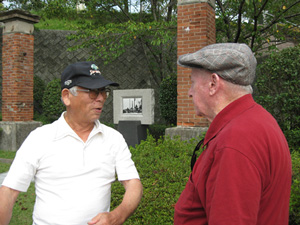
|
|
|
Mr. Versaw, talking with Mr. Ikenushi (left) about bygone days. |
Mr. Robert Rosendahl & his son
Mr. Rosendahl was sent to Shenyang after Bataan Death March. Since he had never stayed in a POW camp in the Japanese homeland, he enjoyed visiting a hot spring in Beppu City, Ohita Prefecture. He might have been stationed there during the occupation period.
For his POW experiences, refer to the article in the NYT website.
The Szwabos
On 14 September, they attended an exchange meeting with the NGO "Peace Aichi" in Nagoya. On 15 September, they visited Ishihara Sangyo Yokkaichi factory (Nagoya No. 5 Branch camp). Toru Fukubayashi of the POW Research Network accompanied them to Yokkaichi.
When he made an application for this invitation, he mentioned that he had worked at Mitsubishi in Nagoya. Therefore, the Foreign Ministry planned to have them visit Mitsubishi Electric Co. in Nagoya. However, no record indicated that the said company had ever used POWs during the war, As a result of researches by the POW Research Network and the US-Japan Dialogue on POWs, it turned out that he had been detained in Nagoya No. 5 Branch camp, and worked at Ishihara Sangyo Yokkaichi factory.
As Ishihara Sangyo had accepted a visit of Mr. Heimbuch , a former US POW last year, the Szabows were received with much courtesy; the Company guided them through the factory, and showed them to the memorial monument for the POWs. Then they spent some time for an informal talk together.
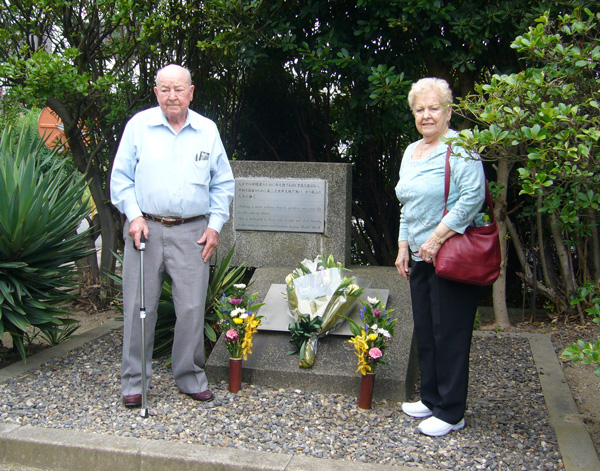
|
|
|
The Szwabos placed bouquets before the memorial monument for the deceased POWs in the grounds of Ishihara Sangyo Yokkaichi factory. |
Ms. Janice Thompson & Ms. Nancy Kragh
Their fathers were sent to Japan aboard the tragic Ohryoku-Maru. Ms. Thompson's father survived, and met with the termination of the war in Shenyang. Ms. Kragh's father was transshipped to the Enoura-Maru after the sinking of the Ohryoku-Maru. While she was at anchored in Takao harbor, was attacked by the US carrier-based aircraft, and he was killed. They wanted to visit the Moji harbor where many POWs had arrived after "hellish voyages."
In Moji, they met with Ms. N (89 years old), who lived next door to the POW camp (Fukuoka No. 4 Branch camp). The YMCA building was used as a POW camp. Since Ms. N's father owned and operated a dock-yard, he had some POWs work at the dock-yard, and she used to watch POWs march in file to work. When Ms. Thompson said according to her father, after he regained his health, he carried bodies of his deceased colleagues to a crematory. On his way back, an elderly couple gave him a double handful of onions. Ms. N mentioned that in those days, vegetables were hard to get in Japan. After the war was over, when the relief items were air-dropped over the camp, the POWs brought some of them to her house and said, "We are friends now." Ms. N got married during the war, and showed them a photo. She wore a traditional Japanese wedding kimono, but her husband wore a government issued familiar a men's civilian wartime uniform. After meeting with Ms. N, they visited the Moji harbor where many POWs had disembarked, and the Moji station, where their respective trips to various places in Japan by train had originated. On the following day, they joined the Versaws and visited Dazaifu-Temmangu shrine near Fukuoka.
16 Sept. (Thurs): Visiting the Ryozen Kannon in Kyoto
On the evening of September 15, the 14 members arrived at Kyoto, and on the following 15th, they visited the Ryozen Kannon where the rosters of the Allied POWs who deceased during WWII is kept. Ms. Tokudome and Ms. Ibuki of the US-Japan Dialogue of POWs, Mr. Fukubayashi and Ms. Nishizato of the POW Research Network joined them.
Due to lack of communications with the temple, and a Buddhist priest, who was not familiar with the matter looked after them, they saw the cards for the US POWs, but could not open the cases in which the rosters were kept without the keys. Ms. Kragh, who found the card of her father killed aboard Enoura-Maru, was filled with thousands emotions, and began crying. She said, "I do not remember my father, because I was only 2 and half years old when parted with him. I thought, even though I could find his card, I would not have any particular feelings about it. I never expected to get so emotional. After the war, I was told that since the US had won the war, everybody should be happy, and we were not allowed to express our sorrow of losing our father. Especially living with my mother, who stayed single fostering two daughters, we were forbidden to behave unhappily in our childhood. Later on, I joined feminism movements, and have been holding out doggedly. Probably, the suppressed grief suddenly spouted out when I saw my father's card."
"There is no winner in war." said Mr. Jackfert, "Especially, the victims of the Oryoku-Maru and Enoura-Maru were killed by friendly fire." So saying, he showed a distressed look on his face.
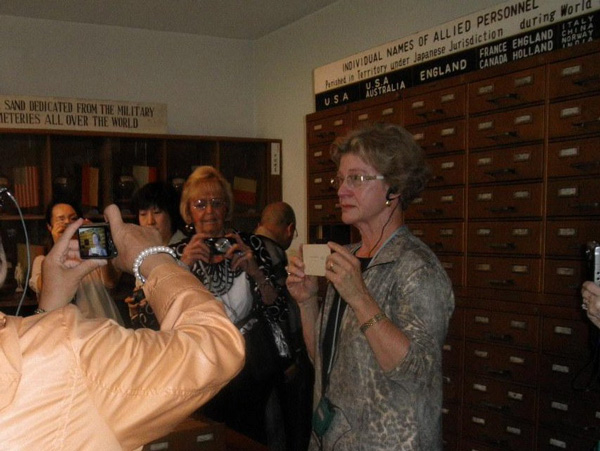
|
|
|
Ms. Kragh finds her father's card. Behind her are card boxes. |
17 Sept. (Fri):
Lecture at Diet Members' League to Promote International Initiatives of Change
The meeting was held at 102 Conference room of the Members' Office Building of the House of Councilors. The former POWs and their family members, a total of 14 people, Chairman of Diet Members' League to Promote International Initiatives of Change , former Prime Minister Tsutomu Hata, 11 members of the House of Representatives/Councillors, former Secretary of the Japan Federation of Economic Organizations Mr. Yano, and members of the Foreign Ministry. A member of the House of Councilors, Mr. Yukihisa Fujita acted as master of ceremonies. A total of seven individuals attended from the "Japanese Society for Friendship with ex-POWs and families", the US-Japan Dialogue on POWs, and POW Research Network.
After expressing his gratitude for the invitation and apology of the Japanese Government, Dr. Tenney, the leader of this visiting group, introduced each member of the group, then talked about his own wartime experiences, and appealed that Mitsui, Mitsubishi, Nihon-sharyo, Kawasaki-Juko, and other Corporations, which had used POWs as slave labors and mistreated them should apologize.
Farewell party sponsored by the Foreign Ministry
The party was held at the Prince Park-Tower hotel where they were staying. Seven people attended the party from the POW Research Network.
After speeches were delivered by the sponsor Vice Foreign Minister Takemasa, Dr. Tennney, Mr. Jackfert and others, Meimeihyo (POW's individual card), which the Foreign Ministry had obtained from the Ministry of Health, Labor and Welfare were handed out to the former POWs. It seems that not everyone was given his own Meimeihyo.
18 Sept. (Sat):
Visiting the British Commonwealth War Cemetery in Yokohama
The group of 14 people arrived at the cemetery on a large bus. Two members from the POW Research Network met them. They were interviewed by the Newsweek and TBS.
Although the cemetery is for the deceased soldiers of the British Commonwealth, 48 US POWs also sleep here. Most of them were the survivors of the Oryoku-Maru and Enoura-Maru. Then they deceased immediately after arriving at Moji aboard Brazil-Maru. Ms. Nancy Kragh told the following story when she was interviewed by Ms. Satoko Kogure. "My father was a doctor. We lived in the PI until I was three years old. My mother had never talked about my father. When I asked her about him, she gestured to me that she did not want to talk. As there was no his ashes, we could not make a gravesite. When my mother passed away 10 years ago, and buried her at a military cemetery, I had my father's name engraved on the tombstone. In/about 2000, I found a photo of my father taken at Cabanatuan POW camp, and was able to locate a person who had taken the photo with him. It was the first time I ever was told a story on my father from a person who had known him. Although my father had never been to Japan, I never did expect to get this sentimental as I am now."
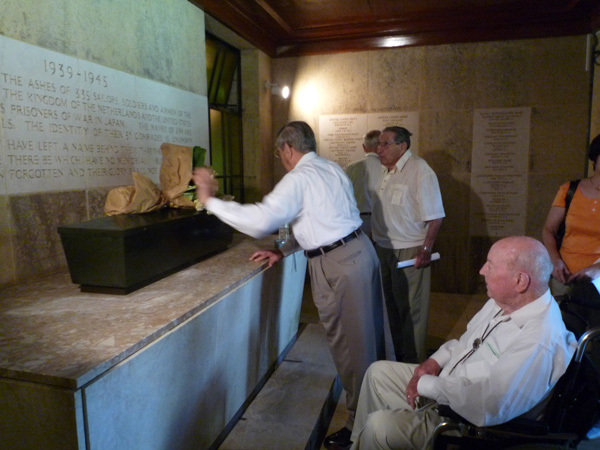
|
|
|
The ossuary where 48 USPOWs sleep. |
An exchange meeting with the Japanese citizens
Presided by: POW Research Network, US-Japan Dialogue on POWs, and "Japanese Society for Friendship with ex-POWs and families"
First session: 1400-1530, Second session: 1530-1700
Place: B1 Room C, AP Hamamatsu-cho, Tokyo
Interpreters: Kinue Tokudome and Yuka Ibuki; Master of ceremonies: Taeko Sasamoto
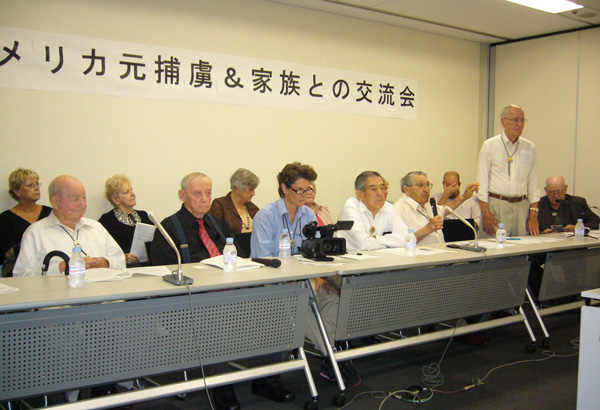
|
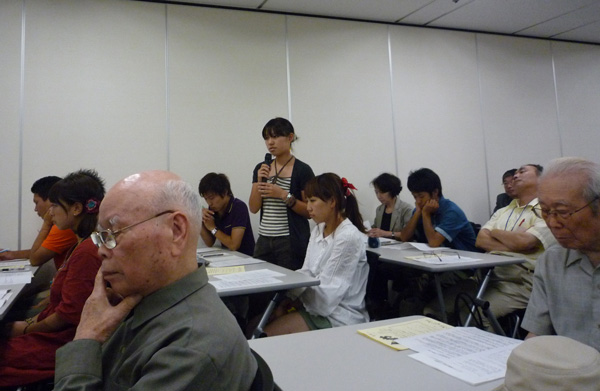
|
|
Visiting members |
Young and old attended the meeting |
Mass Media
Domestic
<13 Sept. Japan Times> Former US POWs arrive in Japan on Government invitation
>>Link
<14 Sept. Japan Times> Okada apologizes for US POWs treatment
>>Link
<15 Sept. The Asahi Shimbun> Japan apologizes for Bataan Death March
>>Link
<15 Sept. The Mainich Daily News> Ex-POWs touring Japan disappointed at not receiving apologies from firms over slave labor
>>Link
Overseas
<12 Sept. AP> Japan Foreign Minister apologizes to US POWs
>>Link
<13 Sept. Wall Street Journal> Former US POWs visit Japan as first-time guest
>>Link
<13 Sept. Wall Street Journal: Video Clip> US POWs want Japan apology
>>Link
<13 Sept. Wall Youtube> Former US POWs seek apologies from Japan
>>Link
<15 Sept. CNN> American POWs seek acknowledgement
>>Link
<24 Sept. Wheeling Intelligencer> Japan apologizes to WW2 POWs / Local veteran witnesses long-sought atonement (Jackfert interview)
<24 Sept. St. Louis Beacon> Florissant man a former POW in World War 2 returns to Japan to accept a nation apology (Szwabo & Thompson interview)
>>Link